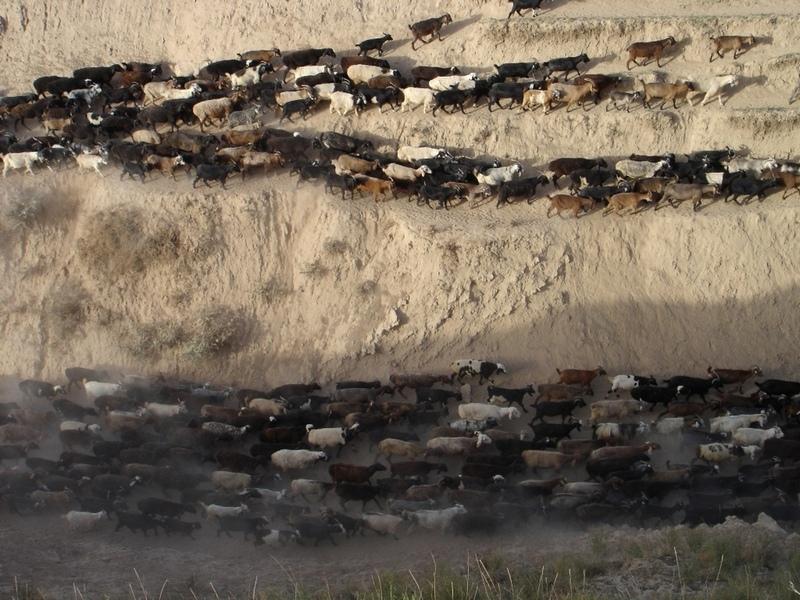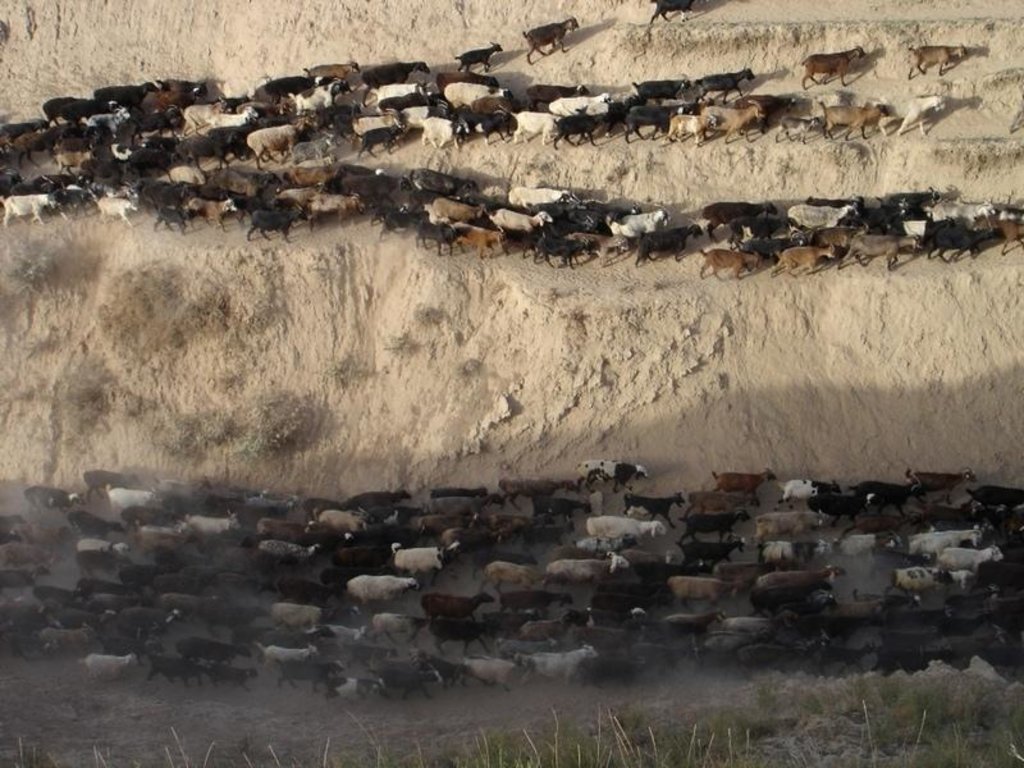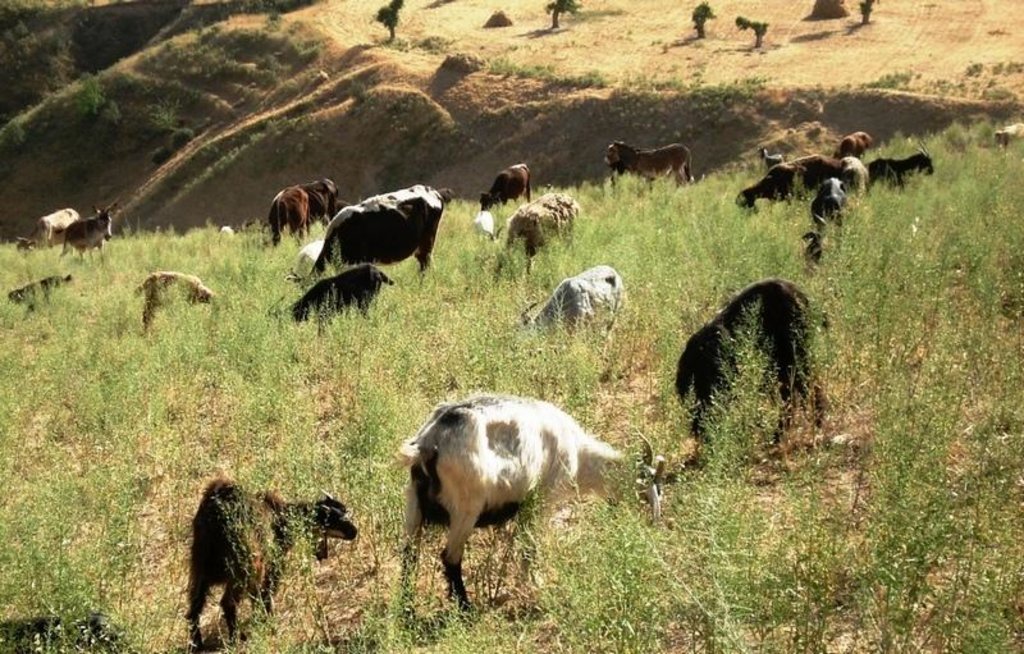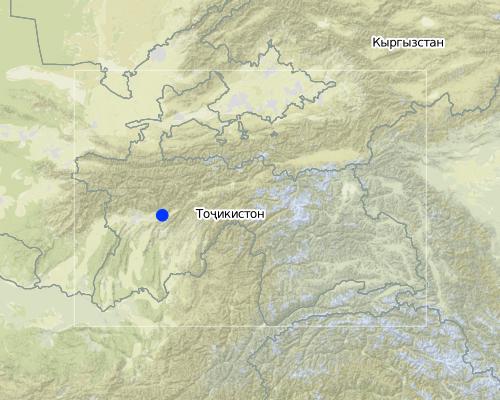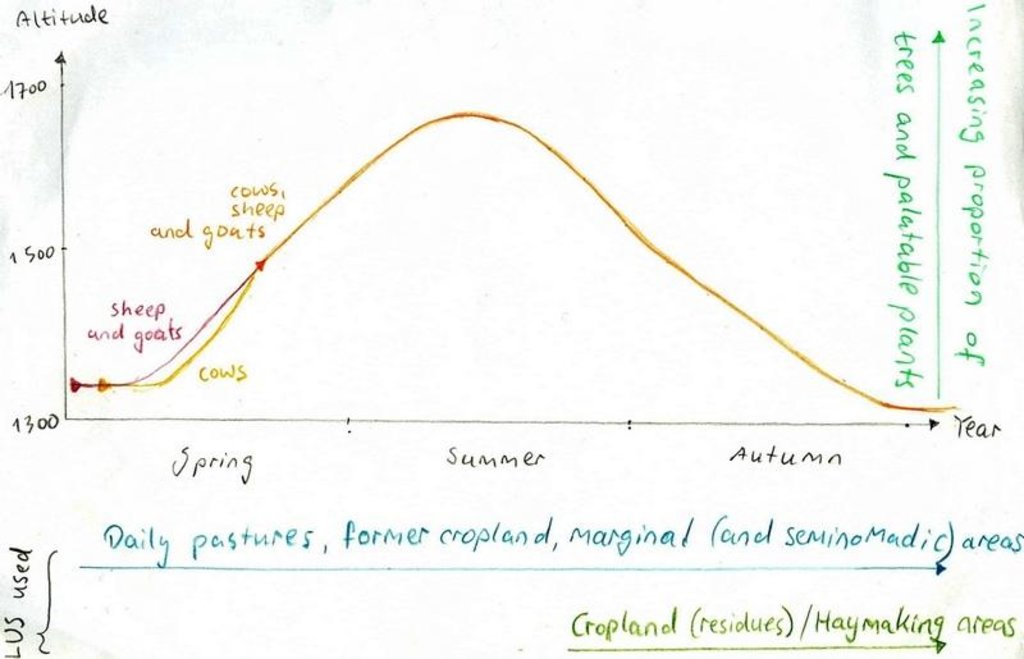Daily grazing of village-herds [طاجيكستان]
- تاريخ الإنشاء:
- تحديث:
- جامع المعلومات: Christian Wirz
- المحرر: –
- المُراجع: David Streiff
Charogo bistumi (pasture for everyone)
technologies_1408 - طاجيكستان
عرض الأقسام
توسيع الكل طي الكل1. معلومات عامة
1.2 تفاصيل الاتصال بالأشخاص الرئيسيين لمصدر المعلومات والمؤسسات المشاركة في تقييم وتوثيق التقنية
اسم المؤسسة (المؤسسات) التي سهلت توثيق/تقييم التقنية (إذا كان ذلك على صلة)
CDE Centre for Development and Environment (CDE Centre for Development and Environment) - سويسرااسم المؤسسة (المؤسسات) التي سهلت توثيق/تقييم التقنية (إذا كان ذلك على صلة)
NCCR North-South (NCCR North-South) - قرغيزستان1.3 الشروط المتعلقة باستخدام البيانات الموثقة من خلال WOCAT
متى تم تجميع البيانات (ميدانيا)؟:
01/08/2008
يوافق جامع المعلومات والشخص (لاشخاص) الرئيسي لمصدر المعلومات على الشروط المتعلقة باستخدام البيانات الموثقة من خلال WOCAT:
نعم
1.5 الإشارة إلى الاستبيان (الاستبيانات) حول مناهج الإدارة المستدامة للأراضي
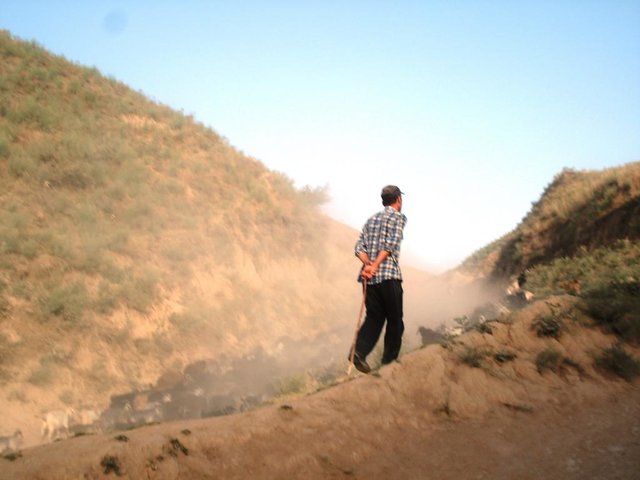
Common village herding [طاجيكستان]
Village herding system with daily alternation of the herders including each household in a monthly turnus.
- جامع المعلومات: Christian Wirz
2. وصف تقنيةالإدارة المستدامي للأراضي
2.1 وصف مختصر للتقنية
تعريف التقنية:
Rotational grazing on village pastures with heavy pressure with daily to weekly change of grazing places.
2.2 وصف تفصيلي للتقنية
الوصف:
The herding season is from the beginnning of March to the End of Octobre or even beginning of Decembre. Total area is between 10-20 km2, depending on how strictly the borders are understood. Cows, sheep, goats and donkeys compose the herds. Grazing begins when soil moisture begins to decreaset, first with the little animals, that are supposed to better cope with slippery conditions. After two weeks the cows are led to the pastures and in some cases they will be grazed alone, because sheep and goats disturb them. The grazing zone is situated between 1400 and 1700 m. Rotation begins on the lower pastures, at the beginning of summer the higher pastures are used and towards autumn the animals graze near the villages again, sometimes on cropland, feeding on crop residues. The herders are advised to change place after 2-3 days, but often stay in one place for a longer time. The animals are gathered on the way out of the village a little after dawn, than brought to the pastures. At noon-time they will be lead to a shady place close to a stream, if possible. The same places are visited three or more times per season.
Purpose of the Technology: The animals should be nourished and the cows should give milk. A land user kept his cow at home towards the end of summer, because it stopped giving milk, from the sparse and dry vegetation on the pastures.
Establishment / maintenance activities and inputs: The costs for this form of herding are lost days at school for the children. It largely works without external inputs (such as fertilisers). Other inputs such as salt for the animals are covered by the landowner.
Natural / human environment: These pasture-areas are heaviliy suffering from overuse on one hand and from droughts on the other side. They are in a generally well-conserved state. Fractional vegetation cover is low, especially tree cover, and the proportion non-palatable species relatively high. Erosion by water, including gullies, and crusting, are common phenomena, especially in low cover areas.
2.3 صور التقنية
2.5 البلد/المنطقة/المواقع التي تم تنفيذ التقنية فيها والتي يغطيها هذا التقييم
البلد:
طاجيكستان
المنطقة/الولاية/المحافظة:
Region of Republican Subordination
مزيد من التفاصيل حول الموقع:
Faizabad
Map
×2.6 تاريخ التنفيذ
في حالة عدم معرفة السنة بالتحديد، يرجى الإشارة إلى التاريخ التقريبي:
- منذ أكثر من 50 عامًا (تقليدي)
2.7 إدخال التقنية
حدد كيف تم إدخال التقنية:
- كجزء من النظام التقليدي (> 50 عامًا)
التعليقات (نوع المشروع، الخ):
Already before the USSR the villages used to have their hamlets and grazed them around the villages, but also in the formerly not very populated plains. By the settlement of people in the plains and population growth from the 1970ies onward livestock numbers and pressure on natural resources started to increase there. And through Soviet collective agriculture people were forced to keep livestock close to the villages, as a consequence of their employment. In addition, grazing on the territory of forest administration, founded in the 1960ies, was forbidden for the villagers.
3. تصنيف تقنية الإدارة المستدامي للأراضي
3.2 نوع (أنواع) استخدام الأراضي الحالية حيث يتم تطبيق التقنية

أراضي الرعي
أراضي الرعي الواسع النطاق:
- مربى ماشية محدد
الأنواع والمنتجات الحيوانية الرئيسية:
sheep and goats / cows and donkeys.
التعليقات:
Major land use problems (compiler’s opinion): Soils are heavily degraded in the sense of generally high levels of compaction and crusting and low organic matter contents. Vegetation is especially reduced in cover, not necessarily in biomass and, the fraction of good pasture species is low.
Major land use problems (land users’ perception): Many trees have been cut down during civil war and till today, leaving back a soil without protection. Animals grazing on these pastures are not fat, often sick and cows give little and sometimes (in summer) no milk. An often mentioned problem is the situation of drought in 2008 and animals staying in one place for longer periods, which leads to degradation of vegetation.
Ranching: sheep and goats / cows and donkeys.
Grazingland comments: In spring sheep and goats are herded before cows, then in a separate herd and toward the end of the season, together.
Type of grazing system comments: In spring sheep and goats are herded before cows, then in a separate herd and toward the end of the season, together.
3.3 مزيد من المعلومات حول استخدام الأراضي
إمدادات المياه للأرض التي يتم تنفيذ التقنية عليها:
- بعلية
عدد مواسم الزراعة في السنة:
- 1
حدد:
Longest growing period in days: 270Longest growing period from month to month: Oct - Jul
كثافة الثروة الحيوانية (إذا كانت ذات صلة):
< 1 LU/km2
3.4 مجموعةالإدارة المستدامة للأراضي التي تنتمي إليها هذه التقنية
- الرعي وإدارة المراعي
3.5 انتشار التقنية
حدد انتشار التقنية:
- منتشرة بالتساوي على مساحة
إذا كانت التقنية منتشرة بالتساوي على منطقة ما، فحدد المنطقة التقريبية المغطاة:
- 100-10 كم2
التعليقات:
Total area covered by the SLM Technology is 15 m2.
For some villages figures are available, for instance for Karsang: This village has alltogether 850 ha of common grazing land, for officially 212 cows and 775 little animals. For the whole Jamoat the figures are of around 2500 ha of pasture-land (not all in the study-area) for 2695 cows and 5950 little animals.
3.6 التدابير التقنية في مجال إلادارة المستدامة للأراضي

التدابير الإدارية
- M1: التغيير في نوع استخدام الأراضي
التعليقات:
Main measures: management measures
3.7 الأنواع الرئيسية من تدهور الأراضي التي تناولتها التقنية

تآكل التربة بالمياه
- الوزن(Wt): فقدان التربة السطحية/تآكل السطح
- (Wg):الانجراف الخلجاني/ الخلجان
- (Wm): مجموعة كبيرة من الحركات الأرضية/انزلاقات أرضية

التدهور البيولوجي
- (Bc): تناقص الغطاء النباتي
التعليقات:
Secondary types of degradation addressed: Wt: loss of topsoil / surface erosion, Wg: gully erosion / gullying, Wm: mass movements / landslides, Bc: reduction of vegetation cover
Main causes of degradation: overgrazing (Big livestock numbers on little surface.), poverty / wealth (People depend on livestock and on cheap pastures.)
Secondary causes of degradation: droughts (Many people mention that rainfalls were much lower in 2007-2008 than normally.), population pressure (Especially from the 1970ies onward population increased rapidly.), land tenure (As long as no-one is really responsible for the are, conservation measures are difficult to implement.), war and conflicts (Civil war was detrimental to the (little) economic, non-agricultural sector (textiles, car-parts) and to the institutions, so that many people had to return to agricultural activities.)
3.8 منع أو حد أو عكس تدهور الأراضي
تحديد هدف التقنية فيما يتعلق بتدهور الأراضي:
- الحد من تدهور الأراضي
التعليقات:
Main goals: mitigation / reduction of land degradation
4. المواصفات الفنية، وأنشطة التنفيذ، والمدخلات، والتكاليف
4.1 الرسم الفني للتقنية
4.2 المواصفات الفنية/شروحات الرسم الفني
Rotation of the village herds.
Location: Karsang and other villages. Faizabad
Date: 20.08.09
Technical knowledge required for land users: low (The practiced rotation follows the humour of the herders (often children) and is not complicated.)
Secondary technical functions: improvement of surface structure (crusting, sealing), increase of biomass (quantity)
Change of land use practices / intensity level: The begin of grazing and the rotation is fixed by a village committee. Animals should not stay at one place for longer than 3 days.
4.3 معلومات عامة بخصوص حساب المدخلات والتكاليف
عملة أخرى/ عملة وطنية (حدد):
Somoni
أشر إلى سعر الصرف من الدولار الأمريكي إلى العملة المحلية (إذا كان ذا صلة): 1 دولار أمريكي =:
3,42
4.4 أنشطة التأسيس
| النشاط | نوع التدبير | التوقيت | |
|---|---|---|---|
| 1. | Villagers buy animals, usually 6-10 goats and / or sheep, 1-2 cows and / or donkeys. | إدارية | Constantly size is regulated. |
4.5 التكاليف والمدخلات اللازمة للتأسيس
| تحديد المدخلات | الوحدة | الكمية | التكاليف لكل وحدة | إجمالي التكاليف لكل مدخل | % من التكاليف التي يتحملها مستخدمو الأراضي | |
|---|---|---|---|---|---|---|
| غير ذلك | buy the animals | per year | 1,0 | 1170,0 | 1170,0 | 100,0 |
| إجمالي تكاليف إنشاء التقنية | 1170,0 | |||||
4.6 الصيانة/الأنشطة المتكررة
| النشاط | نوع التدبير | التوقيت/الوتيرة | |
|---|---|---|---|
| 1. | Per capita fee taxes | إدارية | Once per year. |
| 2. | Buying concentrated feed, depending on the financial resources of the land user. | إدارية | Bought once per year, for winter period. |
| 3. | Haymaking and / or buying, depending on labour, financial resources and livestock numbers. | إدارية | June-July, respectively later, if bought. |
| 4. | Medecine and salt for animals | إدارية | Irregularly, resp. daily to weekly. |
4.7 التكاليف والمدخلات اللازمة للصيانة/للأنشطة المتكررة (سنويًا)
| تحديد المدخلات | الوحدة | الكمية | التكاليف لكل وحدة | إجمالي التكاليف لكل مدخل | % من التكاليف التي يتحملها مستخدمو الأراضي | |
|---|---|---|---|---|---|---|
| غير ذلك | Per capita fee taxes | per year | 12,0 | 1,0 | 12,0 | |
| غير ذلك | Buying concentrated feed | kg | 425,0 | 0,53 | 225,25 | |
| غير ذلك | Medecine and salt for the animals | for all animals | 1,0 | 45,0 | 45,0 | |
| إجمالي تكاليف صيانة التقنية | 282,25 | |||||
التعليقات:
The calculated costs apply to each land user's cost for this herding system.
4.8 أهم العوامل المؤثرة على التكاليف
قدم وصفا لأهم العوامل التي تؤثر على التكاليف:
The most important cost factor is buying livestock. Recurrent costs are low, but rent fees for pastures are percieved as being high.
5. البيئة الطبيعية والبشرية
5.1 المناخ
هطول الأمطار السنوي
- < 250 مم
- 251- 500 ملم
- 501 - 750ملم
- 1,000-751 ملم
- 1,500-1,100 ملم
- 2,000-1,500 ملم
- 3,000-2,001 ملم
- 4,000-3,100 ملم
- > 4000 ملم
المنطقة المناخية الزراعية
- شبه قاحلة
Thermal climate class: subtropics
5.2 طوبوغرافيا
متوسط الانحدارات:
- مسطح (0-2%)
- بسيط (3-5%)
- معتدل (6-10%)
- متدحرج (11-15%)
- تلال (16-30%)
- شديدة الانحدار(31-60%)
- فائقة الانحدار (>60%)
التضاريس:
- هضاب/سهول
- أثلام مرتفعة
- المنحدرات الجبلية
- منحدرات التلال
- منحدرات في السفوح
- قاع الوادي
المنطقة الارتفاعية:
- 100-0 متر فوق سطح البحر
- 500-101 متر فوق سطح البحر
- 1,000-501 متر فوق سطح البحر
- 1,500-1,001 متر فوق سطح البحر
- 2,000-1,501 متر فوق سطح البحر
- 2,500-2,100 متر فوق سطح البحر
- 3,000-2,501 متر فوق سطح البحر
- 4,000-3,001 متر فوق سطح البحر
- > 4000 متر فوق سطح البحر
التعليقات والمواصفات الإضافية بشأن التضاريس:
Altidudinal zone: Most pastures are close to the villages, on around 1300-1500 m, but some pastures reach altitudes of 1600-1700 m.
Landforms: The pasture-areas usually follow N-S-ridges and most pastures are in slope-areas.
Slopes on average: Also hilly
5.3 التربة
متوسط عمق التربة:
- ضحل جدًا (0-20 سم)
- ضحلة (21-50 سم)
- متوسطة العمق (51-80 سم)
- عميقة (81-120 سم)
- عميقة جدًا (> 120 سم)
قوام التربة (التربة السطحية):
- متوسط ( طميي، سلتي)
المواد العضوية في التربة السطحية:
- منخفضة (<1%)
إذا كان متاحًا، قم بإرفاق وصف كامل للتربة أو تحديد المعلومات المتوفرة، على سبيل المثال نوع التربة، الرقم الهيدروجيني/ درجة حموضة التربة، قدرة التبادل الكاتيوني، النيتروجين، الملوحة وما إلى ذلك.
Soil texture (topsoil): Loess soils
Soil fertility low: In most places high proportions of non-graminoids and leguminous species.
Topsoil organic matter: High proportion of hot-spots and degrading areas according to Wolfgramm's (2007) hot-brightspot-map.
Soil drainage / infiltration poor: Most soils are crusted and compacted.
5.4 توافر المياه ونوعيتها
منسوب المياه الجوفية:
> 50 م
توافر المياه السطحية:
ضعيف/ غير متوافر
نوعية المياه (غير المعالجة):
مياه الشرب سيئة (تتطلب معالجة)
تعليقات ومواصفات أخرى بشأن نوعية المياه وكميتها:
Ground water table: Often no groundwater, because too hilly
Availability of surface water: Most areas far from open water bodies
Water quality (untreated): No pesticides, but water is contaminated by animal dung.
5.5 التنوع البيولوجي
تنوع الأنواع:
- منخفض
التعليقات والمواصفات الإضافية بشأن التنوع البيولوجي:
In comparison with other areas.
5.6 خصائص مستخدمي الأراضي الذين يطبقون التقنية
التوجه السوقي لنظام الإنتاج:
- الكفاف (الإمداد الذاتي)
- تجاري/سوق
الدخل من خارج المزرعة:
- >50% من إجمالي الدخل
المستوى النسبي للثروة:
- متوسط
أفراداً أو مجموعات:
- فرد/أسرة معيشية
الجنس:
- نساء
- رجال
اذكر الخصائص الأخرى ذات الصلة لمستخدمي الأراضي:
Land users applying the Technology are mainly common / average land users
Difference in the involvement of women and men: Many children are working as herders, because of labour shortage (young men in Russia).
Population density: < 10 persons/km2
Annual population growth: 1% - 2%
30% of the land users are rich (People who have a house made of concrete or with a ribbed roof instead of one made of cement asbesto).
70% of the land users are average wealthy (Compared to the rest of society: People have enough food, children go to school, they have a mud-hou).
Off-farm income specification: Nearly all people have family members (mostly sons) in Russia, who send remittances.
Market orientation of production system subsistence (self-supply): Animals are mainly used for own consumption (meat and milk).
Market orientation of production system commercial / market: Animals are sold, if the family needs money (for medecine or education).
So, it is still better from their perspective to have animals ("as a bank", according to many villagers), than not having this security. And it is comparatively cheap, even if a land user admits that he has to feed his cow with leaves of his muleberry trees, because pastures are so unproductive, that his cow does not give milk anymore (in August).
5.7 متوسط مساحة الأرض المملوكة أو المستأجرة من قبل مستخدمي الأراضي الذين يطبقون التقنية
- < 0.5 هكتارا
- 0.5 - 1 هكتار
- 1 -2 هكتار
- 2 - 5 هكتار
- 5 - 15 هكتار
- 15 - 50 هكتار
- 50 - 100هكتار
- 500-100 هكتار
- 1,000-500 هكتار
- 10,000-1,000 هكتار
- > 10,000 هكتار
هل يعتبر هذا نطاقًا صغيرًا أو متوسطًا أو واسعا (في إشارة إلى السياق المحلي)؟:
- على نطاق صغير
التعليقات:
Average area of land owned or leased by land users applying the Technology 2-5 ha: This corresponds to the average for the whole study-area, including haymaking areas.
Average area of land owned or leased by land users applying the Technology 5-15 ha: Households having a farmer's association mostly have more than the average.
Average area of land owned or leased by land users applying the Technology 15-50 ha: Some rich families even have more land that they rent to others.
5.8 ملكية الأراضي، وحقوق استخدام الأراضي، وحقوق استخدام المياه
ملكية الارض:
- دولة
حقوق استخدام الأراضي:
- وصول مفتوح (غير منظم)
- مجتمعي (منظم)
التعليقات:
Pasture-use is theoretically regulated as described above, but additionally to the village herd there are other herders with private animals using the same pastures.
5.9 الوصول إلى الخدمات والبنية التحتية
الصحة:
- ضعيف
- معتدل
- جيد
التعليم:
- ضعيف
- معتدل
- جيد
المساعدة التقنية:
- ضعيف
- معتدل
- جيد
العمل (على سبيل المثال خارج المزرعة):
- ضعيف
- معتدل
- جيد
الأسواق:
- ضعيف
- معتدل
- جيد
الطاقة:
- ضعيف
- معتدل
- جيد
الطرق والنقل:
- ضعيف
- معتدل
- جيد
مياه الشرب وخدمات الصرف الصحي:
- ضعيف
- معتدل
- جيد
الخدمات المالية:
- ضعيف
- معتدل
- جيد
6. الآثار والتصريحات الختامية
6.1 الآثار التي أظهرتها التقنية في الموقع
الآثار الاجتماعية والاقتصادية
الإنتاج
جودة العلف
التعليقات/ حدد:
Compared with all other areas the proportion of forbs is very high.
إنتاج حيواني
التعليقات/ حدد:
Compared with an efficient grazing rotation, returns (in terms of milk and meat) are very low.
إنتاج الخشب
التعليقات/ حدد:
Very little trees are left because of goats eating them.
تنوع المنتج
التعليقات/ حدد:
During war most people depended on cropland (wheat).
الدخل والتكاليف
عبء العمل
التعليقات/ حدد:
This system does not depend on professional herders, is thus economic, also in financial terms.
الآثار الاجتماعية والثقافية
الأمن الغذائي / الاكتفاء الذاتي
التعليقات/ حدد:
It is better for land users to have communal pastures but worse than having a well-implemented rotational grazing system, but the family does not have to buy meat.
المؤسسات المجتمعية
Livelihoods and human well-being
الآثار الايكولوجية
دورة المياه / الجريان السطحي
الجريان السطحي
التعليقات/ حدد:
Especially trampling paths of livestock are very vulnerable to water erosion
التربة
تكون قشرة التربة السطحية/انسداد مسام التربة
التعليقات/ حدد:
The degree of compaction is higher than elsewhere.
تراص التربة
التعليقات/ حدد:
The degree of compaction is higher than elsewhere.
المادة العضوية في التربة/تحت الطبقة c
التعليقات/ حدد:
Organic matter is very low compared with all other areas. Biomass might be stonger reduced with animals grazing earlier in spring.
التنوع البيولوجي: الغطاء النباتي، الحيوانات
الكتلة الحيوية/ طبقة الكربون فوق التربة
6.3 تعرض التقنية وحساسيتها لتغير المناخ التدريجي والظواهر المتطرفة/الكوارث المرتبطة بالمناخ (كما يراها مستخدمو الأراضي)
الظواهر المتطرفة / الكوارث المرتبطة بالمناخ
الكوارث الجوية
| كيف تتعامل التقنية مع ذلك؟ | |
|---|---|
| عاصفة ممطرة محلية | ليس جيدا |
الكوارث المناخية
| كيف تتعامل التقنية مع ذلك؟ | |
|---|---|
| جفاف | ليس جيدا |
التعليقات:
Pasture areas, that remain the same since the USSR, could be changed every few years to permit their recovery and regrowth of trees, chopped during and after civil war. The very basic rotational schemes existing in all villages are little effective. It is not possible to recognise conservation effects due to the generally very critical state of resources.
6.4 تحليل التكلفة والعائد
كيف يمكن مقارنة العوائد نسبة لتكاليف الإنشاء (من وجهة نظر مستخدمي الأراضي)؟
عوائد قصيرة الأجل:
إيجابي
عوائد طويلة الأجل:
إيجابي قليلا
كيف تتم مقارنة العوائدمع كلفة الصيانة/التكاليف المتكررة (من وجهة نظر مستخدمي الأراضي)؟
عوائد قصيرة الأجل:
إيجابي
عوائد طويلة الأجل:
إيجابي قليلا
التعليقات:
The land users see the problem of reduced productivity when pastures are overexploited. They complain about having to sell animals, but mainly attribute this to droughts.
6.5 اعتماد التقنية
إذا كان متاحًا، قم بتحديد الكمية (عدد الأسر المعيشية و/أو المساحةالمغطاة):
NA
من بين جميع الذين تبنوا التقنية، كم عدد الذين فعلوا ذلك بشكل تلقائي، أي دون تلقي أي حوافز مادية/مدفوعات؟:
- 100-90%
التعليقات:
Comments on acceptance with external material support: No subsidies have been paid for buying livestock. But, as people highly depend on remittances, it can be assumed that these have also been invested into livestock.
100% of land user families have adopted the Technology without any external material support
There is a moderate trend towards spontaneous adoption of the Technology
Comments on adoption trend: Young families who do not yet have livestock are thinking of buying animals in the future. On the other hand herding in the upper areas still has potential and wealthy people might want to send their animals there with professional herders in the future.
6.7 نقاط القوة / المزايا / الفرص التي توفرها التقنية
| نقاط القوة/ المزايا/ الفرص من وجهة نظر مستخدمي الأراضي |
|---|
|
Animal husbandry is an economic basis which permits development. How can they be sustained / enhanced? People should be allowed to keep as much animals as they want to. And the pasture-area should not become smaller. |
| نقاط القوة/ المزايا/ الفرص من وجهة نظر جامع المعلومات أو غيره من الاشخاص الرئيسيين لمصدر المعلومات |
|---|
|
It is the most cheap form of self-sufficient meat-production. How can they be sustained / enhanced? Pasture-quality needs to be preserved, otherwise the carrying-capacity of pastures will be reduced. |
|
Livestock with its semimonetary value is much more stable in value than money on the bank (increasing livestock prices). How can they be sustained / enhanced? Only if alternatives for animal husbandry emerge will the prices for livestock not fall. |
6.8 نقاط ضعف / مساوىء / مخاطر التقنية وسبل التغلب عليها
| نقاط الضعف/ المساوىء/ المخاطر من وجهة نظر مستخدم الأراضي | كيف يمكن التغلب عليها؟ |
|---|---|
| Animals and pastures are less productive (reduced biomass) and pastures show more signs of erosion than those on forest department. There, pasture-areas are bigger and, by consequence, there is more space for herding. | If there were not always more people affording to rent land for orchards or haymaking the pressure on the remaining pastures would not increase. |
| The pastures very much depend on enough water: If there is little rain (like in 2008) animals return hungry from the pastures. | There is hope that the planned water pipe from Rogun (planned giant dam) will bring water for irrigation (of cropland, where animals graze in late summer and where forbs are collected as winter fodder). |
| Rent fees have to be paid, which are percieved as high by some land users. They fear additional per-capita animal taxes. | No more taxes should be introduced and herding should not be stronger regulated, because many people depend on animal husbandry. |
| This herding system is vulnerable to droughts and temperature increase, which are percieved as main degradation causes. Besides this, excessive livestock numbers are seen as a cause of cover reduction and compaction. Especially where animals graze the soil is naked and dry after 2-3 days. | It might be helpful to let the pastures recover for 3-5 years for trees (which bring moisture) to grow. But this might require administration through external institutions and people fear that they will not get back the pastures. |
| نقاط الضعف/ المساوىء/ المخاطر من وجهة نظر جامع المعلومات أو غيره من الاشخاص الرئيسيين لمصدر المعلومات | كيف يمكن التغلب عليها؟ |
|---|---|
| Degradation of soils and vegetation on these relatively small areas is high and the pastures cannot recuperate due to constant pressure. | The pastures need to have periods of recovery. |
| The soils are decreasing in fertility because animal dung is used as energy source. | A not too expensive alternative for hot water might be solar heaters or charcoal. And to counteract general fertility problems interchanging pasture- and haymaking areas would bring dung everywhere. But this would require fencing of the remaining trees in order not to further damage vegetation cover. |
الروابط والوحدات المواضيعية
توسيع الكل طي الكلالروابط

Common village herding [طاجيكستان]
Village herding system with daily alternation of the herders including each household in a monthly turnus.
- جامع المعلومات: Christian Wirz
الوحدات المواضيعية
لا يوجد وحدات مواضيعية


